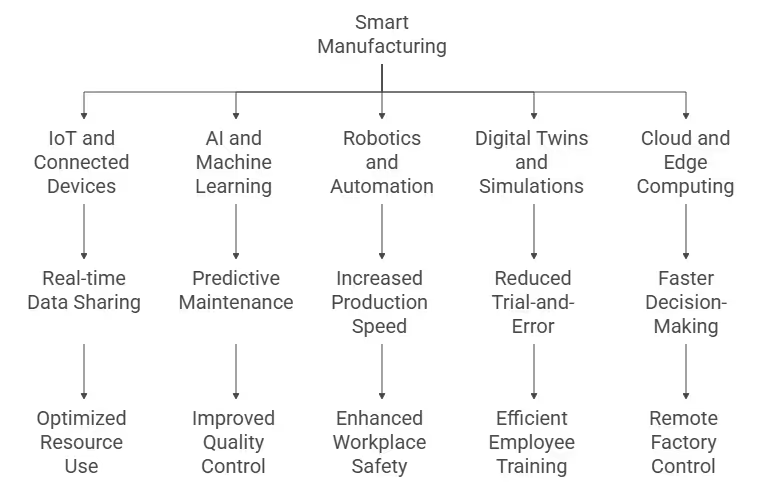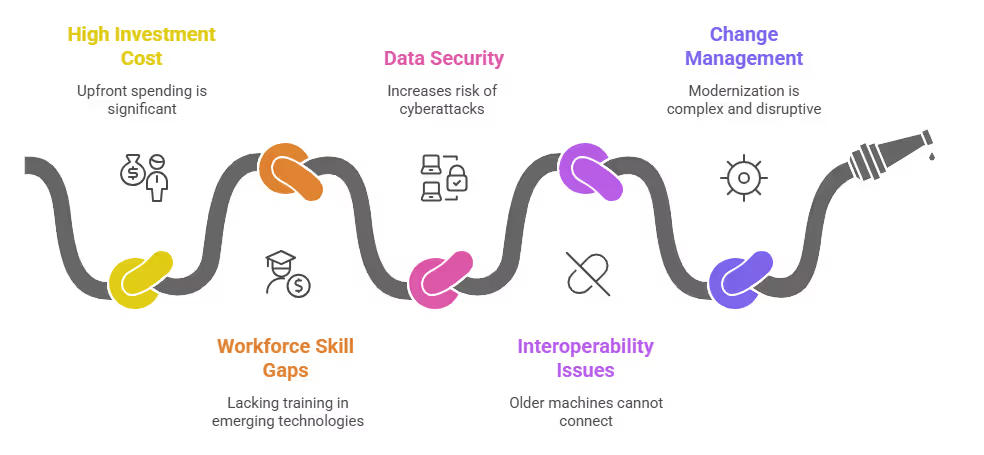Smart Manufacturing and Industry 4.0 Guide for U.S. Industry Leaders

Smart manufacturing and Industry 4.0 are reshaping how factories operate and how products are made. These concepts use modern digital technologies to create factories that are more efficient, flexible, and ready for future challenges.
Here’s an original, clear breakdown of each and how they connect:
What Is Smart Manufacturing?
- Smart manufacturing means using digital technologies like artificial intelligence (AI), industrial IoT (IIoT), cloud computing, and automation to improve the way products are made.
- It is about real-time data collection from sensors and machines to optimize production and make quick decisions. This helps reduce downtime, predict equipment issues, and quickly adapt to changing customer needs.
- The focus is on making specific production processes more efficient through automation, data sharing, and better connectivity between every part of the factory.
- Human workers combine their knowledge with help from data-driven, AI-powered systems for better results. This leads to higher-quality products and safer work environments.
- Smart manufacturing is flexible, factories can quickly change the products they make or improve their workflows without major disruptions.
- Predictive analytics and centralized knowledge systems support faster problem-solving and improve overall supply chain performance.
What Is Industry 4.0?
- Industry 4.0, also called the Fourth Industrial Revolution, is a broader concept. It refers to the transformation of entire manufacturing and industrial operations using digital technologies such as smart sensors, cloud platforms, robots, advanced analytics, and AI.
- This revolution connects machines, workers, and systems into one digital network. Data flows freely across departments, suppliers, and customers, enabling plants to run more independently with less manual intervention.
- The goal is to create fully connected, intelligent manufacturing systems that can optimize every process, from design and production to supply chains and customer service.
- Industry 4.0 covers the entire value chain and aims for complete enterprise-wide connectivity, not just improvements on the shop floor.
How Smart Manufacturing Connects to Industry 4.0
- Smart manufacturing is a key application within the Industry 4.0 framework.
- Think of Industry 4.0 as the overarching vision or blueprint, a system where every part of production, business, and logistics is digitized and connected.
- Smart manufacturing is how these ideas are put into action in factories. It uses the technologies and principles of Industry 4.0 to improve core manufacturing tasks, like production lines, inventory, and quality controls.
- While Industry 4.0 focuses on wide-scale digital transformation of all industrial operations, smart manufacturing drills down on making shop floors more agile, resourceful, and automated through real-time insights and digital tools.
Key Technologies Driving Smart Manufacturing
Smart manufacturing is changing the way factories and industries operate. It combines advanced technologies to create more efficient, flexible, and data-driven production systems. By using digital tools and connected machines, businesses can improve quality, reduce downtime, and respond faster to market demands.
Below are the key technologies driving this transformation:

IoT and Connected Devices
- IoT devices link machines, sensors, and systems across the factory, enabling real-time data sharing.
- These connected assets track equipment health, energy consumption, and production efficiency without manual checks.
- Manufacturers use this data to spot potential failures early, reduce waste, and optimize resource use.
- IoT also supports smart supply chains by giving visibility into inventory levels and logistics.
Artificial Intelligence (AI) and Machine Learning (ML)
- AI and ML analyze huge amounts of data from connected machines and sensors.
- They help manufacturers predict machine breakdowns before they occur, reducing unplanned downtime.
- Algorithms can detect defects in products faster than human inspections, ensuring better quality control.
- Manufacturers also use AI to plan maintenance schedules, improve production forecasting, and optimize energy use.
Robotics and Automation
- Robots handle tasks such as assembly, packaging, and inspection with consistency and precision.
- They free human workers from repetitive and hazardous tasks, improving workplace safety.
- Collaborative robots (cobots) now work alongside humans, adapting to different workflows in real time.
- Automation increases production speed and scalability, especially when demand fluctuates.
Digital Twins and Simulations
- A digital twin is a virtual copy of a product, machine, or process that updates with real-time data.
- Manufacturers use digital twins to test new designs, workflows, or process changes before applying them physically.
- This cuts down on costly trial-and-error methods and reduces the risk of production errors.
- Simulations also help in training employees and planning future factory layouts more effectively.
Cloud and Edge Computing
- Cloud platforms store and process massive industrial data, making it accessible across global teams.
- Edge computing complements this by handling data close to the source, ensuring faster decision-making.
- Together, they balance speed and scalability, edge for quick responses and cloud for deeper insights.
- These technologies support applications like predictive analytics, machine monitoring, and remote factory control.
Smart manufacturing is built on the integration of IoT, AI, robotics, digital twins, and cloud-edge computing. Each of these technologies strengthens different aspects of production, from predictive maintenance and automation to flexible planning and faster innovation. By adopting them, manufacturers can stay competitive, reduce costs, and deliver high-quality products with greater efficiency.
Benefits of Smart Manufacturing for U.S. Manufacturers
Smart manufacturing has become one of the most important shifts in U.S. industry. By combining automation, real-time data, and AI-driven tools, manufacturers can improve productivity while reducing operational costs. This approach is not only about faster production but also about smarter decision-making, predictive maintenance, and building more sustainable operations.
Below are some of the key benefits U.S. manufacturers can achieve with smart manufacturing systems:
Productivity and Efficiency Gains
- Smart manufacturing makes use of connected machines and sensors that provide real-time updates on production.
- This allows managers to track operations instantly and make fast adjustments when bottlenecks or delays occur.
- Automated machinery reduces manual errors and increases the speed of repetitive tasks, which directly improves overall output.
- Digital twin technology helps simulate production processes in advance, ensuring fewer mistakes during manufacturing runs.
- As a result, plants can achieve higher production volumes with the same or fewer resources.
Predictive Maintenance and Reduced Downtime
- Traditional maintenance methods often rely on scheduled checks, which may create downtime even when machines are in good condition.
- Predictive maintenance uses data analytics and IoT sensors to monitor equipment performance in real time.
- The data can trigger alerts when a component is showing signs of wear or unusual vibration patterns.
- Fixing problems before they turn into breakdowns helps avoid costly unplanned stoppages.
- Reduced downtime means production lines stay operational longer, increasing reliability and profitability.
Workforce Augmentation with AI Tools
- Smart manufacturing does not replace people, it supports them with stronger tools and insights.
- AI-driven dashboards analyze large sets of data and highlight actionable insights that employees may miss.
- Augmented reality (AR) and AI-based training tools equip workers with step-by-step digital guidance for complex tasks.
- Collaborative robots (cobots) can handle heavy or repetitive work, allowing humans to focus on strategy, design, or quality checks.
- This balanced approach helps fill skill gaps while making the workforce more productive and safe.
Sustainability and Energy Savings
- Smart manufacturing systems can measure energy consumption across the plant in real time.
- Advanced analytics pinpoint areas of overuse and suggest ways to optimize energy use, such as adjusting machine idle times.
- Automated controls regulate heating, cooling, and lighting to reduce waste where possible.
- Reduced scrap material and optimized production scheduling also mean less environmental impact.
- By lowering energy bills and improving material efficiency, manufacturers achieve both cost savings and sustainability goals.
Challenges and Barriers to Adoption in Smart Manufacturing
Smart manufacturing brings efficiency, flexibility, and data-driven decision-making to factories. However, businesses face major obstacles when they try to adopt these technologies. The transition requires more than just new machines; it demands investment, workforce readiness, secure data handling, and cultural change.
Below are the key challenges that slow down or complicate adoption:

High Cost of Investment
- Advanced technologies like IoT devices, AI-driven analytics, robotics, and digital twins require significant upfront spending.
- Small and medium manufacturers often lack access to the capital needed for large-scale digital upgrades.
- Even when companies can invest, they worry about the return on investment because benefits such as predictive maintenance or real-time insights take time to show.
Workforce Skill Gaps
- Smart manufacturing relies on advanced skills such as data analysis, machine learning, robotics operation, and cybersecurity awareness.
- Many factory workers have strong domain experience but lack training in these emerging technologies.
- Upskilling and reskilling programs require time and resources, and not all organizations have structured learning paths in place.
- The shortage of skilled talent in fields like AI and industrial IoT makes it harder for manufacturers to scale smart solutions.
Data Security and Interoperability
- Smart manufacturing depends on constant data sharing across IoT sensors, cloud platforms, and production systems.
- This open connectivity increases the risk of cyberattacks and data breaches that can disrupt operations.
- Older machines often cannot connect directly with modern digital systems, creating interoperability problems that require expensive middleware or system redesign.
- Lack of universal standards across vendors results in data silos, reducing the effectiveness of analytics and real-time monitoring.
Change Management in Legacy Factories
- Traditional factories often operate with decades-old machines and processes, making modernization complex and disruptive.
- Employees may resist new systems because of fear of job loss, unfamiliarity with digital tools, or comfort with old practices.
- Management teams face challenges in aligning business goals with new digital-first processes.
- Integrating smart technologies without halting ongoing production requires careful planning, staged implementation, and continuous communication with the workforce.
Real-World Applications and U.S. Case Studies of Smart Manufacturing
Artificial intelligence is transforming U.S. industry by delivering smarter automation, higher efficiency, and data-driven decisions. Here are practical examples from automotive, aerospace, food manufacturing, and the smart factory movement to showcase this progress:
Automotive Sector
- Ford streamlines vehicle design with AI-powered agents that convert 2D sketches into 3D prototypes and run real-world stress simulations, cutting design cycles from hours to seconds. This helps Ford bring new vehicles to market quicker and adapt faster to trends.
- Porsche uses AI for predictive maintenance, analyzing diagnostic data to predict failures before they occur. This prevents expensive breakdowns and improves the ownership experience for customers.
- Nissan collaborates with AI startups to evolve autonomous driving, using reinforcement learning on real driving data. The AI learns and adapts to complex road conditions, making self-driving features safer and more reliable.
- Other U.S. players like Tesla and General Motors deploy AI for advanced driver-assist, quality inspections, and personalized in-car systems, integrating machine intelligence across the vehicle lifecycle.
Aerospace & Defense
- Airbus leverages AI-driven simulations to speed up aerodynamic calculations, reducing calculation time from one hour to just 30 milliseconds. This allows engineers to test ten thousand design ideas in the time it took for just one, helping to innovate faster.
- Leading defense contractors like Raytheon, IBM, and Northrop Grumman use AI for electronic warfare, threat detection, autonomous drones, and mission support platforms. These applications improve real-time decision-making and boost operational reliability for national security.
- AI-based predictive maintenance is also used to monitor aircraft health and schedule service before breakdowns occur, increasing fleet uptime and safety.
Food and Beverage Manufacturing
- Kraft Heinz uses an AI-based “Lighthouse” system to monitor supply chains in real time, improving demand forecasting and reducing inventory errors. This digital control tower anticipates disruptions and minimizes waste, boosting operational responsiveness and efficiency.
- A global food and beverage maker adopted AI to reduce unplanned machine downtime, recovering $500,000 in weekly productivity losses and increasing output by 5%. AI helped streamline capex decisions and align workforce productivity with machine availability.
- Leading brands like Mondelez employ AI to accelerate and refine new product flavors, using data-driven insights for faster product development and better consumer targeting.
T-Mobile Smart Factory Example
- In Texas, T-Mobile’s smart factory leverages 5G, AI, and IoT sensors to modernize manufacturing. Machines share data instantly, slashing delays by 40% thanks to real-time connectivity.
- AI-powered computer vision identifies defects instantly, reducing faulty products by 25%. IoT sensors track equipment health, and when a failure seems likely, AI predicts the problem and quickly notifies the team, preventing costly downtime.
- This approach saved $500,000 in downtime in a single year, showing how integrated AI and connectivity deliver direct, measurable impact for U.S. manufacturing.
These cases highlight how AI adoption turns data into value, making American industries more resilient, productive, and competitive in a rapidly changing market.
Smart Manufacturing and Industry 4.0: The Road Ahead
- Smart manufacturing uses advanced digital technologies such as artificial intelligence, the Internet of Things (IoT), and real-time data analytics.
- Industry 4.0 pushes manufacturers towards higher productivity, reduced waste, greater flexibility, and resource efficiency by integrating these digital tools into every production process.
The Role of AI Agents in Factories
- AI agents act as autonomous software systems that learn from and continuously analyze data collected from sensors and machines on the factory floor.
- They perform tasks without constant human oversight, such as controlling production lines, predicting equipment failures, and optimizing resource use. This leads to fewer breakdowns, lower downtime, and higher process efficiency.
- Super AI agents manage multiple layers of AI systems, ensuring all production activities remain coordinated, from raw material procurement to product delivery.
- These agents also adapt to unexpected events by analyzing problems and executing corrective actions, improving with each learning cycle.
- Their integration with enterprise systems like ERP enables end-to-end optimization across the entire factory environment.
Hyperautomation Trends
- Hyperautomation combines AI, machine learning, robotic process automation, and IoT to automate not only repetitive tasks but also complex business decisions.
- Factories now use smart robots that go beyond traditional roles, becoming flexible and able to collaborate with humans.
- Hyperautomation enhances supply chain resilience, improves quality control, and enables predictive maintenance across multiple plants.
- Focus on cybersecurity and IT infrastructure automation is growing rapidly as factories become more interconnected and digitalized.
- Continuous advancements in hyperautomation allow manufacturers to quickly adapt to changing market needs, further improving productivity and quality.
U.S. Government Initiatives and Funding
- The U.S. Department of Energy (DOE) and other agencies have launched dedicated funding opportunities, such as a $33 million grant, to advance smart manufacturing processes and digital innovation for clean energy transition.
- Current initiatives support research in digital twins, high-performance materials, sustainable supply chains, and circular economy manufacturing models.
- The SMART USA funding program specifically aims to address gaps in semiconductor manufacturing using digital twin technology and builds a skilled workforce equipped for digital transformation.
- These investments help U.S. manufacturers adopt cutting-edge technologies, remain globally competitive, and develop more sustainable production systems.
Industry 4.0 is not just about automation but about creating intelligent, self-improving manufacturing systems driven by data and real-time decisions. Factories that embrace these changes will stand at the forefront of the next industrial revolution.
Take Charge with Hakuna Matata
The future of U.S. manufacturing is here, and Industry 4.0 is your ticket to staying ahead. Whether you’re a plant manager upgrading operations or an IT leader securing systems, Hakuna Matata is America’s top agency for smart manufacturing solutions. Our team has helped U.S. giants like Ford and Boeing implement Industry 4.0 and zero trust architecture, delivering 20% efficiency gains.
Get Started Today: Fill out the form below to get our Free Industry 4.0 Readiness Guide and a 1:1 Knowledge Transfer Session with our experts.
Don’t let your factory fall behind, partner with Hakuna Matata to build a smarter, safer future.

